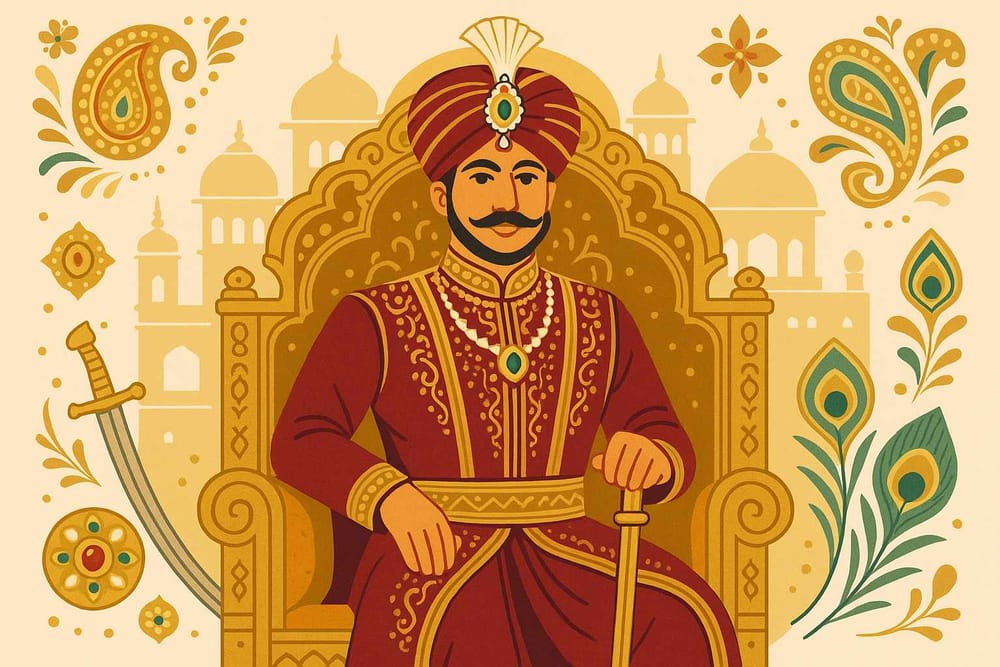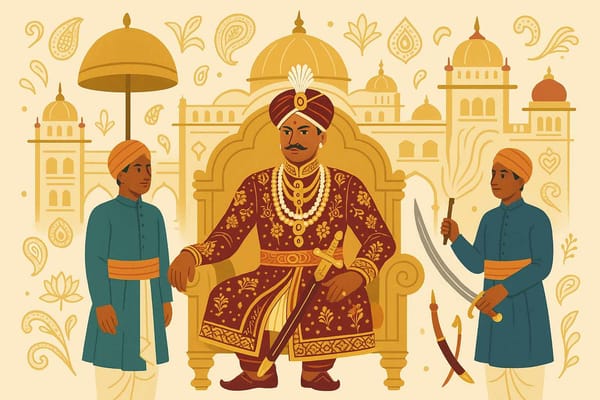
Royal Legacy Explored: Mahārāja's Influence Shapes Indian Culture
Sometimes, when you walk through the bustling lanes of an old Indian city, visit a magnificent fort, or even drape a beautiful Banarasi saree, you feel a connection to a grander time. It's a whisper from the past, a story etched in stone and woven into fabric. These are the living legacies of India’s Mahārājas—the ‘great kings’ who were not just rulers, but the very soul of our cultural identity. Their influence is not just in our history books; it’s in our traditions, our art, and in the pride we feel for our heritage.
More Than Just a Crown: The True Role of a Mahārāja
The title ‘Mahārāja’ brings to mind images of opulent palaces and grand durbars, but their role went far deeper. They were the custodians of dharma, protectors of their people, and patrons of a culture that blossomed under their care. From the ancient Mauryan and Gupta empires to the princely states under British rule, these rulers were responsible for maintaining harmony and nurturing the diverse communities within their vast territories.
Even during the complex era of colonial rule, many Mahārājas stood as bulwarks for Indian traditions. While navigating intricate politics, they ensured that our local arts, rituals, and knowledge systems were not just preserved but celebrated. Their coronations weren't mere political events; they were deeply spiritual ceremonies, elaborate rituals that reaffirmed their sacred duty to their kingdom and its people.
A Canvas of Culture: The Royal Patronage of Arts and Heritage
Have you ever wondered why certain Indian art forms are so intricate and timeless? A large part of the credit goes to the royal courts. Mahārājas were the greatest connoisseurs of art, and their support allowed creativity to flourish, leaving behind a treasure trove for generations to come.
- Art and Architecture: The Maharajas were visionary builders, commissioning forts, temples, and palaces that are now architectural marvels. Think of the stunning City Palace in Jaipur, a masterpiece of planning by Maharaja Sawai Jai Singh II, or the majestic Mysore Palace. Their support also nurtured unique art forms, like the delicate miniature paintings that tell epic tales on a tiny canvas. To truly understand this depth, one can explore Mewar’s rich heritage of traditional arts and crafts, which thrived under royal patronage.
- Music, Dance, and Literature: The royal courts echoed with the sounds of classical music and the graceful movements of dancers. Rulers in the South were instrumental in the development of Carnatic music, while courts in the North nurtured dance forms like Kathak. They weren't just spectators; they were active participants who understood the nuances of melody and rhythm, ensuring these traditions were passed down with reverence.
Legendary Kings Who Defined an Era
The history of India is illuminated by the stories of remarkable rulers whose vision and courage continue to inspire us. These weren't just kings; they were nation-builders, strategists, and reformers.
- Chhatrapati Shivaji Maharaj of the Maratha empire is celebrated not just for his military genius but also for his groundbreaking administrative reforms that prioritized the welfare of his people.
- Maharaja Ranjit Singh, the "Lion of Punjab," is remembered for unifying the Sikh territories and fostering an environment of religious harmony and respect.
- Visionaries like Maharaja Sawai Jai Singh II of Jaipur blended tradition with scientific progress, giving us the incredible Jantar Mantar observatories. Others, like Maharaja Sayajirao Gaekwad III of Baroda, championed modernization by making primary education free and compulsory, investing in a future for his people.
The Royal Touch in Our Festivals and Modern Life
The grandeur of India's royal legacy is most vividly felt during our festivals. The scale and community spirit of celebrations like Dussehra in Mysore or Holi in the Braj region often trace their roots back to royal traditions. The spectacular elephant processions, the elaborate temple rituals, and the public feasts were all part of how Mahārājas celebrated with their subjects, reinforcing a sense of shared cultural identity. These royal traditions continue to shape local celebrations, preserving a unique heritage that connects us to our past.
This influence extends into our daily lives too. The elegant sherwani, a staple at Indian weddings, evolved from royal court attire. The timeless grace of handwoven sarees was perfected under the patronage of queens and noblewomen. Even our cuisine carries the flavours of royal kitchens, where secret recipes were passed down through generations.
This deep connection between royalty and devotion—building temples, sponsoring festivals, and embedding faith into the fabric of daily life—is a powerful reminder of our spiritual roots. The stories and devotional literature that flourished in these kingdoms are timeless. At Bhaktilipi, we are dedicated to this very cause: preserving and sharing these sacred stories for today's generation. If you feel a connection to this rich heritage, explore our collection of timeless devotional literature on Bhaktilipi.in.
Honoring a Timeless Legacy
Today, the legacy of the Mahārājas is not a relic of the past; it is a living, breathing part of modern India. Their magnificent palaces have been transformed into heritage hotels, allowing us to experience a slice of their world. Royal families continue to be custodians of their heritage, working to support local artisans and preserve their ancestral traditions.
The stories of their leadership, their love for art, and their commitment to their people serve as a powerful bridge between our past and our future. They remind us of a time of grandeur, vision, and deep-rooted cultural pride. In every corner of India, the influence of the Mahārājas remains, a testament to a legacy that continues to enrich and define the soul of our nation.
A passionate group of people dedicated to preserving India's knowledge of Dharma, Karma, and Bhakti for ourselves and the world 🙏.
Comments
Related in

The Majestic Life of the Maharaja of Mysore - Explored
There's a certain magic in the air in Mysore, a feeling that history isn't just in books but is alive, breathing in the grand corridors of its palaces and the festive spirit of its streets. At the heart of this magic is the story of the
